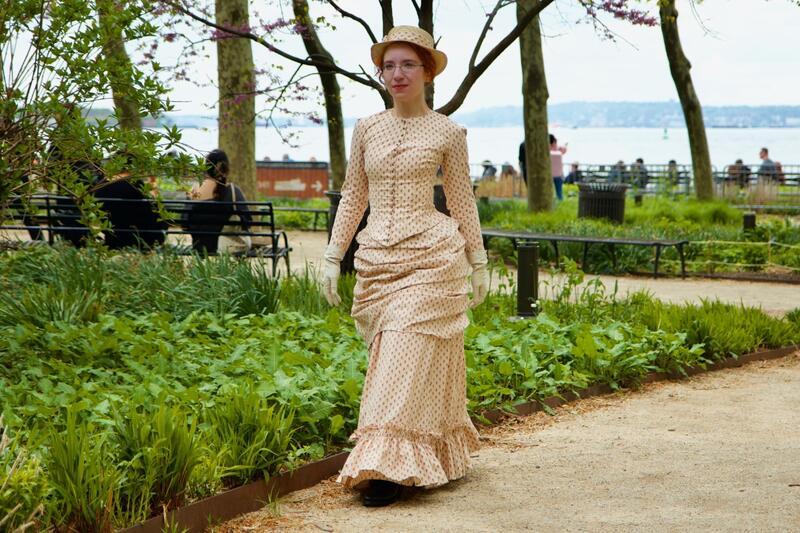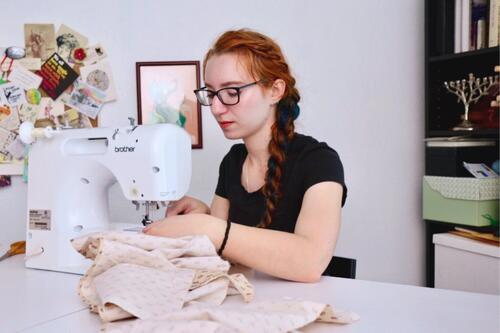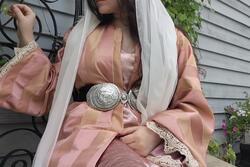7 Questions For Vi
JWA talks to Vi, historical costume designer and creator of the YouTube channel SnappyDragon.
JWA: What kickstarted your interest in historical fashion?
Vi: Three things. I loved sci-fi and fandom when I was growing up. People would dress up in cosplay and really outlandish clothes just for fun. From 2005 to 2015, steampunk, fashion corsets with twenty-first century clothes, and elaborate dresses—like, a TARDIS dress, for example—were all really big at [conventions]. And one of the best things about being in those spaces was dressing up. I also learned to sew a little bit as a teenager—basically, how to operate a sewing machine—because clothes never fit me. So I had to learn how to alter things.
I’ve always been into historical fiction. I’d have some book I was enjoying and wanted a better understanding of what was going on for its characters in the background. I’d end up on Wikipedia…down a historical fashion rabbit hole. In 2018-2019, I was at a point in my life where I needed something positive and fulfilling. I thought, What did you always want to do when you grew up? And I realized I wanted to make amazing costumes like the people I saw and admired.
JWA: What was your favorite film with historical costumes growing up?
Vi: I would see people dressing up at conventions, but often, it wasn’t something out of film. It was people wearing costumes they just liked and enjoyed, not specific recreations. The environment I grew up in was really contemptuous of traditionally feminine interests. Watching historical costume films would have been seen as a waste of your time or something that would rot your brain. Somehow, this did not apply to genre fantasy classics. But costume films were not something I was encouraged to watch. I now have this really strong interest in legitimizing the history of traditionally feminine things. This is serious history and these things are important! Hair care and clothing are important lenses into cultural history. They’re not meaningless fluff.
JWA: If you had an unlimited budget, what's one outfit you would go all-out in recreating?
Vi: I would remake this dress from the Metropolitan Museum of Art. It has an amazing shape, and I really love this period of time for dresses. I think this one is from the 1850s, so we’re talking big sleeves, hoop skirt, fitted bodice, interesting fabric, and optical illusions. The fabric would cost an absolute fortune, because it has a specific rose design woven into it and it’s embossed. If I had the biggest fabric budget ever, this is what I’d want to make.
But if I had unlimited time, I would probably create a dress from twelfth-century Jewish England—which is a community I’m interested in for costumes and history. Just to see what it’s like. Can I get wool cloth of similar variety and quality to that time? Wool yarn so that it’s not sha’atnez [clothing containing both linen and wool, prohibited by the Torah]? Hemp so I don’t use linen? It would take months.
JWA: What’s one thing you wish people knew about historical Jewish clothing?
Vi: The thing I’m always trying to remind people of is that if you picture the clothes being worn in the most popular settings for costumers—English history included—there were most likely Jews in those environments. And they wore those clothes, too. In medieval and Renaissance Europe, most parts of the Mediterranean, and the colonial Americas, there were Jewish people there, and still are. If you’re imagining clothes from those places, you are imagining Jewish clothes. How were Jews dressing similarly and differently? I want to know, but this is the information that’s not well recorded. There’s a lot of guesswork. A lot of this information would have been passed down person to person without being written down.
One of my biggest questions is about an entire period in Western fashion history— from the sixteenth to the eighteenth century— when one of the major dressmaking techniques involves using a heavy linen structural layer and an outer layer made from wool. So what are Jewish tailors using instead? My guess is hemp. And when the Reform movement [started], you probably had Reform Jews saying it’s an old restriction, and they began using linen and wool.
JWA: Is there any advice you would give to people who are interested in recreating historical clothing, but may not have the funds to do so in the same way that their favorite creators do?
Vi: Here’s the advice I would give: Don’t let anyone else set your standard for you. You decide what makes your project a fulfilling experience. Don’t let someone tell you there’s a right level of historical accuracy, don’t let anyone tell you about fabric you must use, or what research you must do. It’s up to you. Do what’s gonna make it a good experience for you. If someone thinks you should’ve done something differently, they should make their own project. If you wanna use synthetic fibers, don’t let someone tell you that you can’t do that. Don’t listen to people who are snobby. There are people who have a preference for natural fibers, and that’s fine. Don’t be afraid to use household textiles like bed sheets or curtains; you can get them on Buy Nothing or Freecycle [groups]. If you’re getting stuff secondhand, you’ll be doing good for the environment and your budget.
JWA: What’s one thing that repeatedly stands out to you in your research and crafting process?
Vi: Honestly, human nature. The phrase “the past is a foreign country” comes up for me a lot. On the one hand, you don’t want to assume past people have the same social values or are operating the same as you, but you also don’t want to let differences or details prevent you from seeing the human angle under, say, the social structure of the time. People always did what made sense to them. They used what they had available and had relatable experiences as they made sense of the world around them. The experiences we have today still existed but may have looked different. There were still arguments in newspapers about women’s fashion. Women are going out in daytime pajamas! So that’s not a new problem. People have been acting like their opinions are relevant even if no one asked for them for a very long time. These make history feel relatable and connectable.
JWA: What’s an upcoming project that you’re excited about?
Vi: I’m hesitant to describe it in too much detail here, because it’s in the absolute earliest stages. I’m planning something hopefully for 2024. It involves Renaissance fairies, Shakespeare, and a whole bunch of people in costume, and potentially is the biggest project I've ever done. It's not specifically focused on Jewish identity. I didn’t choose any of the people working with me on it because they’re Jewish. So it’s Jewish because Jewish people are working on it, and their Jewishness will come through in that art. In the meantime, I’ve been working on my new series [on YouTube].
I hope that my new series encourages people to think more about how we talk about the stories of marginalized people—of ordinary people, working-class people in history—and how modern society affects how we do or don’t tell those stories. I hope it encourages marginalized people to see themselves as having just as much of a place in this big story we call history, because their ancestors were there. They had to be. Because we’re here today.







